1998 CHEVROLET EXPRESS child lock
[x] Cancel search: child lockPage 24 of 386
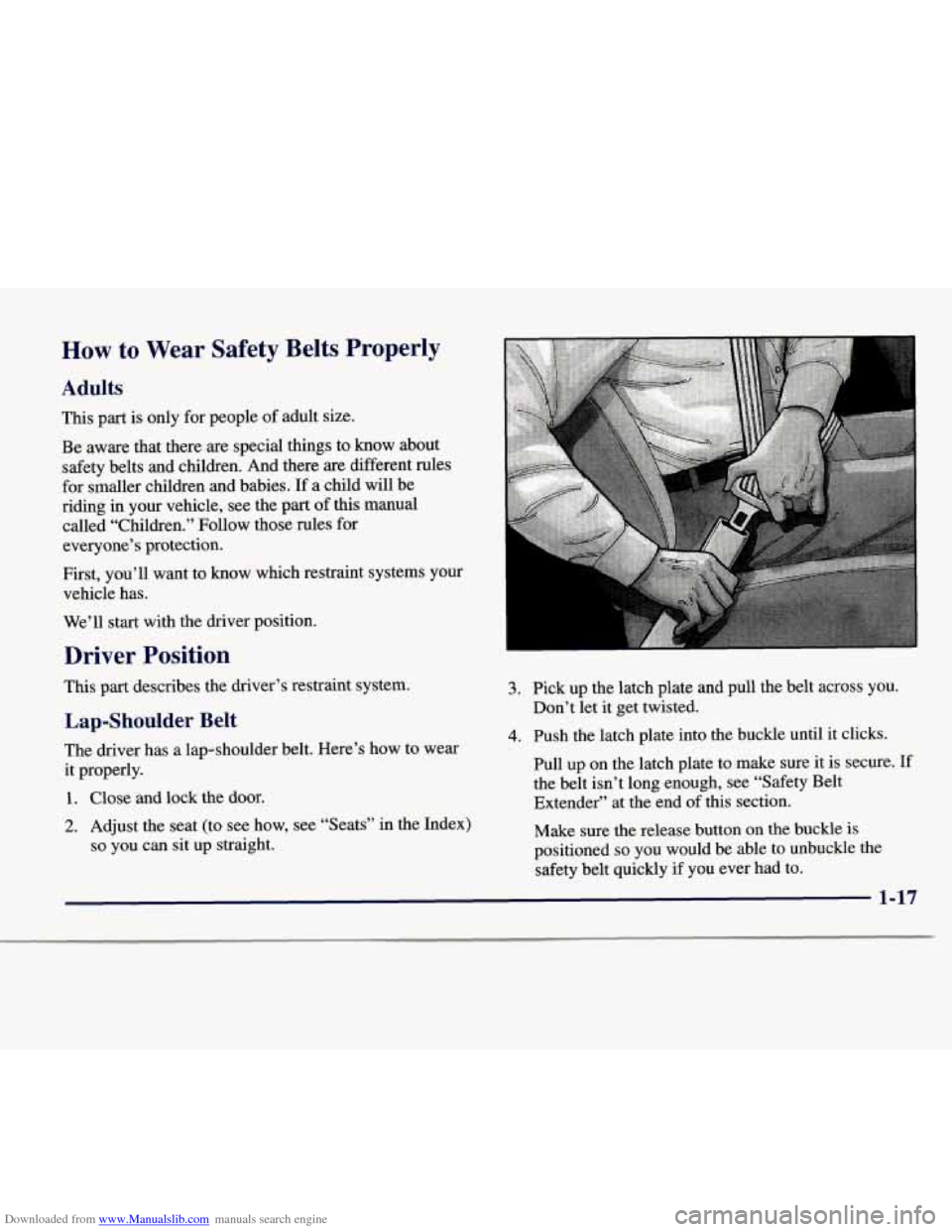
Downloaded from www.Manualslib.com manuals search engine How to Wear Safety Belts Properly
Adults
This part is only for people of adult size.
Be aware that there
are special things to know about
safety belts
and children. And there are different rules
for smaller children and babies. If a child will be
riding in your vehicle, see the part of this manual
called “Children.” Follow those rules for
everyone’s protection.
First, you’ll want to know which restraint systems your
vehicle has.
We’ll start with the driver position.
Driver Position
This part describes the driver’s restraint system.
Lap-Shoulder Belt
The driver has a lap-shoulder belt. Here’s how to wear
it properly.
1. Close and lock the door.
2. Adjust the seat (to see how, see “Seats” in the Index)
so you can sit up straight.
3. Pick up the latch plate and pull the belt across you.
Don’t let it get twisted.
4. Push the latch plate into the buckle until it clicks.
Pull up on the latch plate to make sure it is secure.
If
the belt isn’t long enough, see “Safety Belt
Extender” at the end of this section.
Make sure the release button on the buckle is
positioned
so you would be able to unbuckle the
safety belt quickly if you ever had to.
1-17
Page 33 of 386
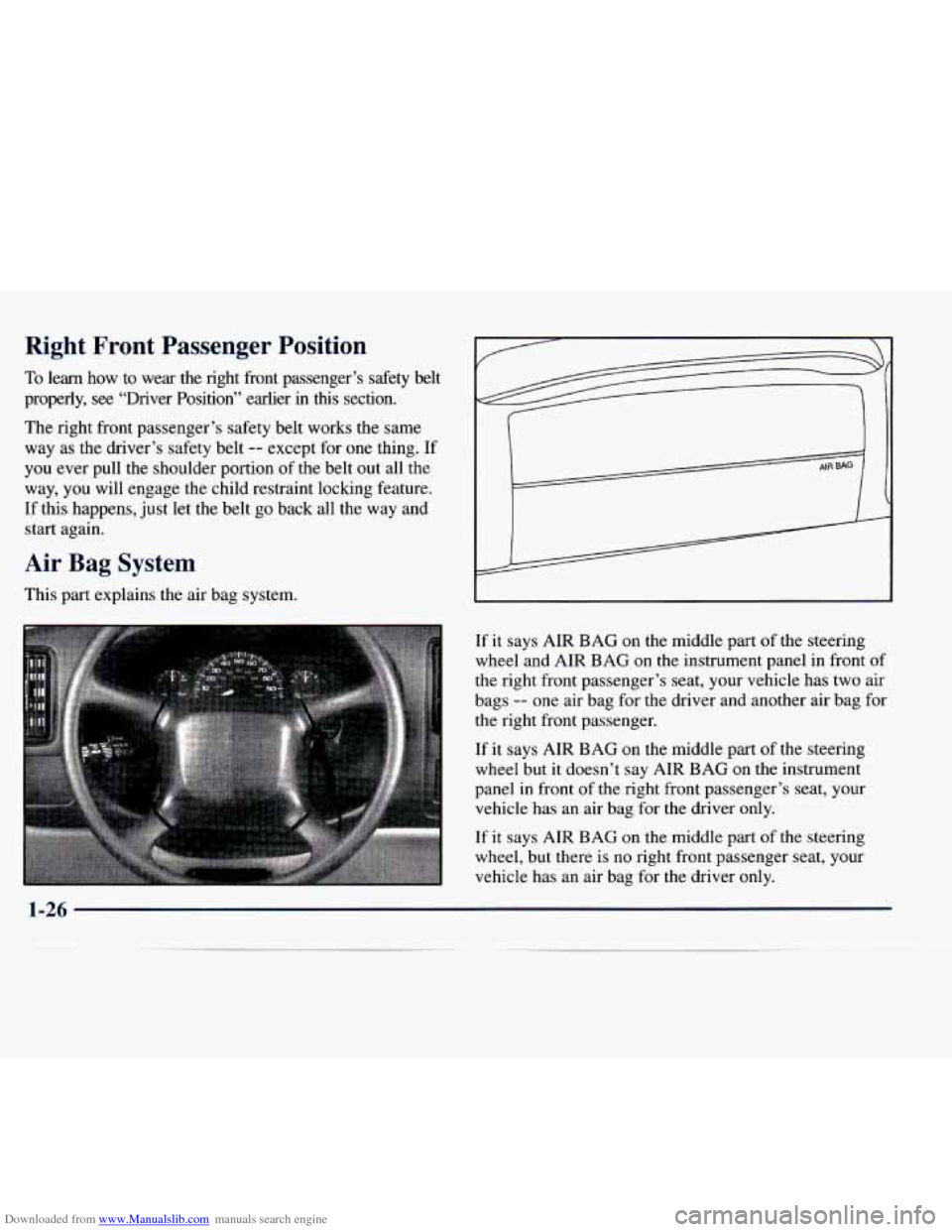
Downloaded from www.Manualslib.com manuals search engine Right Front Passenger Position
To learn how to wear the right front passenger’s safety belt
properly,
see “Driver Position” earlier in this section.
The right front passenger’s safety belt works the same
way as the driver’s safety belt
-- except for one thing. If
you ever pull the shoulder portion
of the belt out all the
way, you will engage the child restraint locking feature.
If this happens, just let the belt go back all the way and
start again.
Air Bag System
This part explains the air bag system.
If it says AIR
BAG on the middle part of the steering
wheel and AIR BAG on
the instrument panel in front of
the right front passenger’s seat, your vehicle has two air
bags
-- one air bag for the driver and another air bag for
the right front passenger.
If it says
AIR BAG on the middle part of the steering
wheel but it doesn’t say AIR BAG on the instrument
panel in front of the right front passenger’s
seat, your
vehicle has an air bag for the driver only.
If
it says AIR BAG on the middle part of the steering
wheel, but there is no right front passenger seat, your
vehicle has an air bag for the driver only.
1-26
-
Page 60 of 386
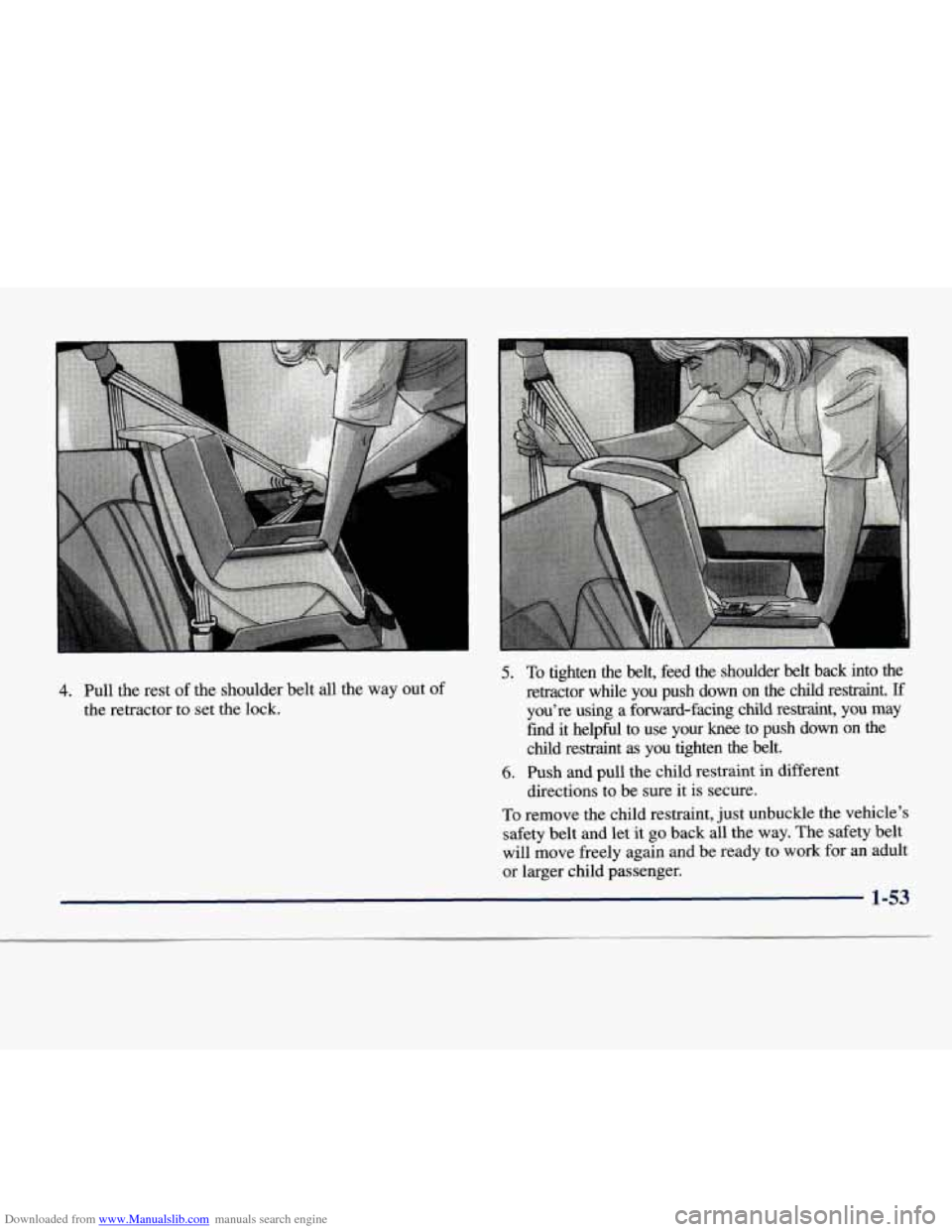
Downloaded from www.Manualslib.com manuals search engine 4. Pull the rest of the shoulder belt all the way out of
the retractor to set the lock.
5. To tighten the belt, feed the shoulder belt back into the
retractor while you push down on the child restraint.
If
you’re using a forward-facing child restraint, you may
find it helpful to use your
knee to push down on the
child restraint
as you tighten the belt.
directions to be sure it is secure.
6. Push and pull the child restraint in different
To remove the child restraint, just unbuckle the vehicle’s
safety belt and let it
go back all the way. The safety belt
will move freely again and be ready to work for an adult
or larger child passenger.
1-53
Page 75 of 386

Downloaded from www.Manualslib.com manuals search engine Door Locks
Unlocked doors can be dangerous.
Passengers
-- especially children -- can easily
open the doors and fall out. When
a door is
locked, the inside handle won’t open it.
Outsiders can easily enter through an unlocked
door when you slow down or stop your vehicle.
This may not be
so obvious: You increase the
chance
of being thrown out of the vehicle in a
crash if the doors aren’t locked. Wear safety belts
properly, lock your doors, and you will be far
better
off whenever you drive your vehicle.
There are several ways to lock and unlock your vehicle.
If your vehicle is equipped with remote keyless entry,
see “Keyless Entry System” later in this section for
more information.
From the outside, use your key.
.F To lock the door from the
inside, slide the lever on
your door down.
To unlock the door, slide
the lever up.
2-4
Page 76 of 386
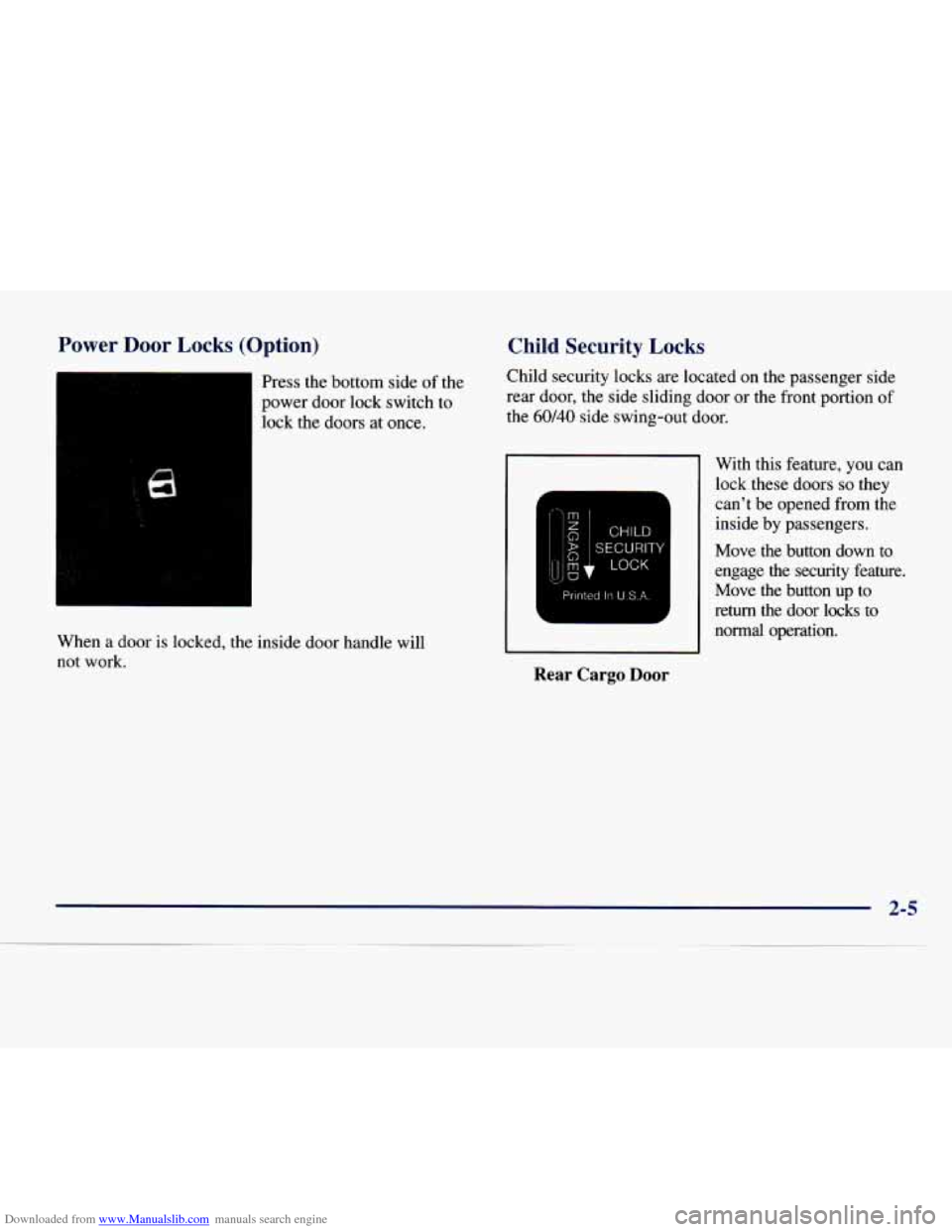
Downloaded from www.Manualslib.com manuals search engine Power Door Locks (Option)
Press the bottom side of the
power door lock switch to
lock the doors at once.
When a door is locked, the inside door handle will
not work.
Child Security Locks
Child security locks are located on the passenger side
rear door, the side sliding door
or the front portion of
the 60/40 side swing-out door.
CHILD
SECURITY
LOCK
Printed In U.S.A.
Rear Cargo Door
With this feature, you can
lock these doors
so they
can’t be opened from the
inside by passengers.
Move the button down to
engage the security feature.
Move the button up to
return the door locks to
normal operation.
2-5
Page 77 of 386

Downloaded from www.Manualslib.com manuals search engine 60/40
“4 CHILD 1
$, ~ SECURITY
LOCK w
L A
Side Sliding Door
Move the button to the
left to engage the
security feature. Move
the button to the right to
return the door locks to
normal operation.
Move the button
up to
engage the security
feature. Move the button
down to return the door
locks to normal operation.
Keyless Entry System (If Equipped)
If your vehicle has this option, you can lock and unlock
your doors from about
3 feet (1 m) up to 30 feet (9 m)
away using the remote keyless entry transmitter supplied
with your vehicle.
Your keyless entry system operates on a radio frequency
subject to Federal Communications Commission (FCC)
Rules and with Industry Canada.
2-6
Page 173 of 386
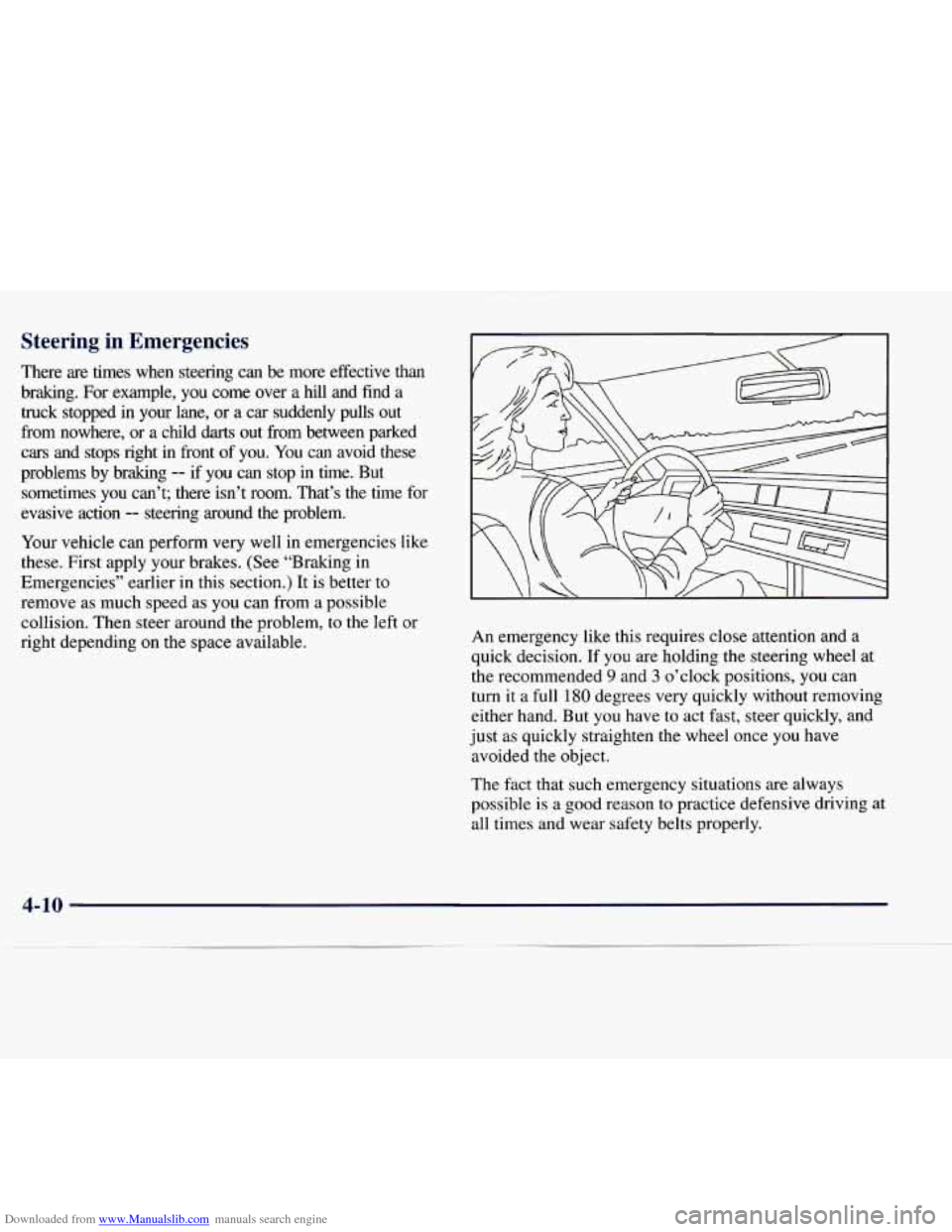
Downloaded from www.Manualslib.com manuals search engine Steering in Emergencies
There are times when steering can be more effective than
brakmg. For example, you come over a hill and find a
truck stopped in your lane, or a car suddenly pulls out
from nowhere, or a child darts out from between parked
cars and stops right in front
of you. You can avoid these
problems by braking
-- if you can stop in time. But
sometimes
you can’t; there isn’t room. That’s the time for
evasive action
-- steering around the problem.
Your vehicle can perform very well in emergencies like
these. First apply your brakes. (See “Braking in
Emergencies” earlier in this section.) It is better to
remove as much speed as you can from a possible
collision. Then steer around the problem,
to the left or
right depending on the space available. An
emergency like this requires
close attention and a
quick decision. If
you are holding the steering wheel at
the recommended
9 and 3 o’clock positions, you can
turn it a full
180 degrees very quickly without removing
either hand. But you have to act fast, steer quickly, and
just as quickly straighten the wheel once you have
avoided the object.
The fact that such emergency situations are always
possible
is a good reason to practice defensive driving at
all times and wear safety belts properly.
4-10
Page 379 of 386

Downloaded from www.Manualslib.com manuals search engine Leaving Your Vehicle with the Engine Running ....... 2-27
Lighter
........................................ 2-48
Lights Air Bag Readiness
....................... 1-28, 2-54
Anti-Lock Brake System Warning
............ 2-57, 4-7
Brake System Warning
......................... 2-56
Charging System
............................. 2-54
Daytime Running Lamps Indicator
............... 2-62
Safety Belt Reminder
..................... 1- 12, 2-53
Security
.................................... 2-61
Service Engine Soon
.......................... 2-58
Loading Your Vehicle
........................... 4-27
Ignition Transmission Check
.................... 7-41
Sliding Door Child Security ...................... 2-6
Lubricants and Fluids
............................ 7-44
Lubrication Service, Body
........................ 7-39
CheckGages
................................ 2-62
Exterior
.................................... 2-40
Interior
..................................... 2-43
Locks
......................................... 2-4
Door
........................................ 2-4
PowerDoor
.................................. 2-5
RearDoorSecu
rity ............................. 2-5
LossofControl
................................ 4-12
Maintenance. Normal Replacement parts
........... 6-69
Maintenance Record
............................ 7-46
Maintenance Schedule
............................ 7-1
Long Tripmighway
........................... 7-27
Long Tripmighway Definition
................... 7-6
Long Tripmighway Intervals
..................... 7-7
Owner Checks and Services ..................... 7-38
Periodic Maintenance Inspections
................ 7-42
Recommended Fluids and Lubricants
............. 7-44
Scheduled Maintenance Services
.................. 7-4
Short Trip/City
................................ 7-8
Short Trip/City Definition ....................... 7-5
Short Trip/City Intervals
........................ 7-5
Maintenance. Underbody
......................... 6-58
Maintenance When Trailer Towing
................. 4-36
Malfunction Indicator Lamp
...................... 2-58
Camper-Type
................................ 2-47
Convex Outside
.............................. 2-46
Inside Daymight Rearview
..................... 2-45
Power Remote Control
......................... 2-45
Model Reference
................................. vi
MountainRoads
................................ 4-21
Multifunction Lever
............................. 2-34
ManualFrontSeat
........,...................... l-2
Mirrors ....................................... 2-45
Visorvanity
................................. 2-49
MMT ......................................... 6-4
Neutral. Automatic Transmission ................. 2-22
New Vehicle Break-In
........................... 2-17
Nightvision
................................... 4-14
Noise Control System
........................... 6-11
Normal Maintenance Replacement
Parts ............. 6-69
Odometer
.................................... 2-52
Odometer. Trip
................................. 2-52
9-6